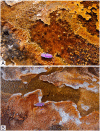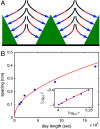Biophysical basis for the geometry of conical stromatolites
- PMID: 20479268
- PMCID: PMC2890478
- DOI: 10.1073/pnas.1001973107
Biophysical basis for the geometry of conical stromatolites
Abstract
Stromatolites may be Earth's oldest macroscopic fossils; however, it remains controversial what, if any, biological processes are recorded in their morphology. Although the biological interpretation of many stromatolite morphologies is confounded by the influence of sedimentation, conical stromatolites form in the absence of sedimentation and are, therefore, considered to be the most robust records of biophysical processes. A qualitative similarity between conical stromatolites and some modern microbial mats suggests a photosynthetic origin for ancient stromatolites. To better understand and interpret ancient fossils, we seek a quantitative relationship between the geometry of conical stromatolites and the biophysical processes that control their growth. We note that all modern conical stromatolites and many that formed in the last 2.8 billion years display a characteristic centimeter-scale spacing between neighboring structures. To understand this prominent-but hitherto uninterpreted-organization, we consider the role of diffusion in mediating competition between stromatolites. Having confirmed this model through laboratory experiments and field observation, we find that organization of a field of stromatolites is set by a diffusive time scale over which individual structures compete for nutrients, thus linking form to physiology. The centimeter-scale spacing between modern and ancient stromatolites corresponds to a rhythmically fluctuating metabolism with a period of approximately 20 hr. The correspondence between the observed spacing and the day length provides quantitative support for the photosynthetic origin of conical stromatolites throughout geologic time.
Conflict of interest statement
The authors declare no conflict of interest.
Figures




Similar articles
-
Morphological record of oxygenic photosynthesis in conical stromatolites.Proc Natl Acad Sci U S A. 2009 Jul 7;106(27):10939-43. doi: 10.1073/pnas.0900885106. Epub 2009 Jun 29. Proc Natl Acad Sci U S A. 2009. PMID: 19564621 Free PMC article.
-
[Biomineralization at hot springs and mineral springs, and their significance in relation to the Earth's history].Biol Sci Space. 2000 Dec;14(4):363-71. doi: 10.2187/bss.14.363. Biol Sci Space. 2000. PMID: 11589228 Japanese.
-
Stromatolites in Precambrian carbonates: evolutionary mileposts or environmental dipsticks?Annu Rev Earth Planet Sci. 1999;27:313-58. doi: 10.1146/annurev.earth.27.1.313. Annu Rev Earth Planet Sci. 1999. PMID: 11543060 Review.
-
The role of microbes in accretion, lamination and early lithification of modern marine stromatolites.Nature. 2000 Aug 31;406(6799):989-92. doi: 10.1038/35023158. Nature. 2000. PMID: 10984051
-
The oldest records of photosynthesis.Photosynth Res. 1992;33:75-89. Photosynth Res. 1992. PMID: 11538389 Review.
Cited by
-
Pattern formation in stromatolites: insights from mathematical modelling.J R Soc Interface. 2012 May 7;9(70):1051-62. doi: 10.1098/rsif.2011.0516. Epub 2011 Oct 12. J R Soc Interface. 2012. PMID: 21993008 Free PMC article.
-
Surface orientation affects the direction of cone growth by Leptolyngbya sp. strain C1, a likely architect of coniform structures Octopus Spring (Yellowstone National Park).Appl Environ Microbiol. 2013 Feb;79(4):1302-8. doi: 10.1128/AEM.03008-12. Epub 2012 Dec 14. Appl Environ Microbiol. 2013. PMID: 23241986 Free PMC article.
-
Cyanophycin mediates the accumulation and storage of fixed carbon in non-heterocystous filamentous cyanobacteria from coniform mats.PLoS One. 2014 Feb 7;9(2):e88142. doi: 10.1371/journal.pone.0088142. eCollection 2014. PLoS One. 2014. PMID: 24516596 Free PMC article.
-
Morphogenesis of digitate structures in hot spring silica sinters of the El Tatio geothermal field, Chile.Geobiology. 2022 Jan;20(1):137-155. doi: 10.1111/gbi.12471. Epub 2021 Sep 30. Geobiology. 2022. PMID: 34590770 Free PMC article.
-
Morphological optimization for access to dual oxidants in biofilms.Proc Natl Acad Sci U S A. 2014 Jan 7;111(1):208-13. doi: 10.1073/pnas.1315521110. Epub 2013 Dec 12. Proc Natl Acad Sci U S A. 2014. PMID: 24335705 Free PMC article.
References
-
- Semikhatov MA, Gebelein CD, Cloud PE, Awramik SM, Benmore WC. Stromatolite morphogenesis-progress and problems. Can J Earth Sci. 1979;16:992–1015.
-
- Allwood AC, Walter MR, Kamber BS, Marshall CP, Burch IW. Stromatolite reef from the Early Archaean era of Australia. Nature. 2006;441:714–718. - PubMed
-
- Grotzinger JP, Knoll AH. Stromatolites in Precambrian carbonates: Evolutionary mileposts or environmental dipsticks? Ann Rev Earth Pl Sc. 1999;27:313–358. - PubMed
-
- Martin A, Nisbet EG, Bickle MJ. Archean stromatolites of the Belingwe Greenstone Belt, Zimbabwe (Rhodesia) Precambrian Res. 1980;13:337–362.
Publication types
MeSH terms
Grants and funding
LinkOut - more resources
Full Text Sources
Molecular Biology Databases

